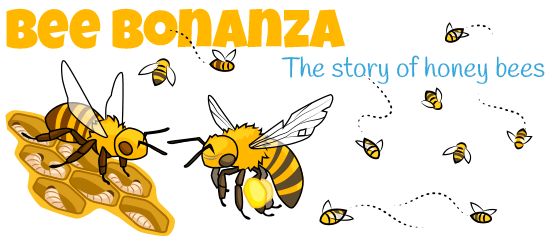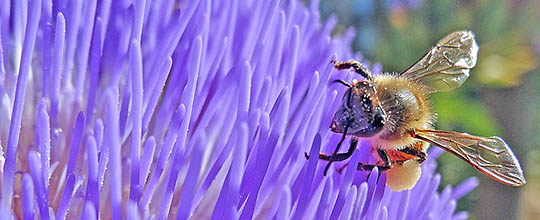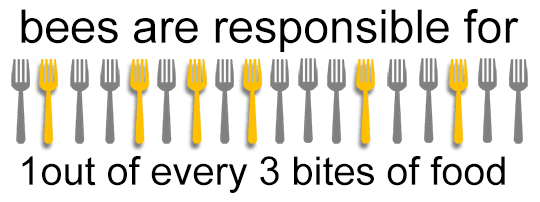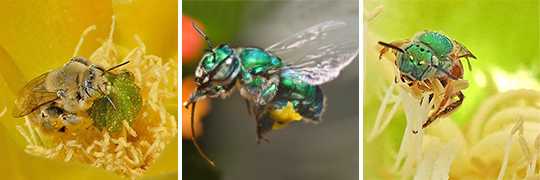
Illustrated by: Sabine Deviche
show/hide words to know
Efficient: doing a job or task without wasting time or energy.
Gnarl: a rough twisted grained part, also called a knot, on a tree or branch.
Hive: the place where honeybees store their food, find shelter, and house their young.
Larva: the second, "worm-like" stage in the life cycle of insects that undergo complete metamorphosis (like caterpillars).
Pollinate: moving pollen from the male to the female component of a flower as part of the fertilization process in plants. Birds and insects often move pollen from flower to flower when gathering nectar and they are therefore called pollinators... more
Proboscis: a long mouth part found in most insects and some other animals used to suck up food.
Thorax: in general the part of the body between the neck and waist in humans and the central part of an insects body where the legs and wings are attached... more
The World of Honey Bees
While walking through the park on a warm afternoon, you hear a soft humming in the air. This humming gradually builds into a low roar as you approach the old hollow tree in the center of the park. You’ve walked by this old gnarled willow a hundred times, but today you notice a line of bees. The bees soar back and forth out of the tree like hundreds of little buzzing helicopters.
You make a mental note to give this old tree a wide berth. But wonder for a moment what it would be like to join the bee colony and travel inside the hollow.

Honey bee collecting pollen from an artichoke flower. Its face is dotted with pollen and the hind legs are packed with pollen. Image by Charles Kazilek.
If you were one of the worker bees that collects pollen and nectar you would be traveling in and out of the nest. When inside you see hanging sheets of comb with its hexagon cells. There are bees busy working the honey-filled cells on both sides. Some of the workers are building new cells. Others bees are tending to the young larvae. A very large bee is moving from cell to cell laying eggs. This is the queen. You go to a cell and deposit your nectar that was collected from a flower rich in the sweet fluid. This is just part of the life of a bee and what it is like inside a colony. There is much more that biologists are learning about these insects.
Honey Bee Basics
These hard-working little creatures are a vital part of our ecosystem. Scientists sometimes say that bees are responsible for one out of every three bites of food we eat. They pollinate so many food plants that make our meals delicious and nutritious, including many fruits, vegetables and nuts. Bees spend their lives collecting pollen, which provide a source of protein to their developing youngsters. As pollen collects on their hairy legs, they move some of the pollen from the male to the female part of a flower. This fertilizes the female flowers and starts the process of making seeds for the next generation of plants.
Although most bees and many insects and birds are pollinators, the honey bee is a favorite pollinator by farmers because their hives can be moved to different locations. Bees are extremely efficient in the pollination process. You might have read or heard that honey bees are disappearing and if that is true, our food supply could be at risk.

Bee Talk

What looks like squiggly lines and arrows to you is actually one way bees communicate through dance.
Honey bees have an amazing way to communicate with each other. It’s not the same way you would talk to your sister or even to your pet. What do bees do? They dance. It is true. Worker bees returning to the hive with nectar or pollen tell other worker bees how to find the flower through dance. Biologists call it the waggle dance. You can even try it yourself, although your sister might look at you like you’re a little weird. Maybe a better way to learn about the bee dance is to play the Waggle Dance Game.
Are All Bees the Same?
Did you know there are many more species of bees than just the common honey bee? Scientists have discovered and cataloged thousands of different types of bees. There is even an Africanized honey bee that has a reputation for being more aggressive than its European honey bee cousin. Some bees are social like the honey bee and other bees solitary, like digger bees, and orchid bees.
Explore some bee anatomy and become an expert on spotting honey bees. Learn the difference between an antenna and a proboscis. Perfect your skills at identifying male and female honey bees. Then become a real detective so you can tell the differences between a honey bee, a wasp, a bumblebee and other kinds of bees.

There are over 20,000 species of bees. None of these bees are honey bees. On the left is a carpenter bee. In the middle is an orchid bee. On the right is a sweat bee.
This section of Ask A Biologist was funded in part by NSF Grant Award number 1556337.
Additional images via Wikimedia Commons. Honeybee collecting nectar close up by Bob Peterson.
View Citation
Bibliographic details:
- Article: Bee Bonanza
- Author(s): Christopher M. Jernigan
- Publisher: Arizona State University School of Life Sciences Ask A Biologist
- Site name: ASU - Ask A Biologist
- Date published: June 12, 2017
- Date accessed: April 17, 2024
- Link: https://askabiologist.asu.edu/explore/honey-bees
APA Style
Christopher M. Jernigan. (2017, June 12). Bee Bonanza. ASU - Ask A Biologist. Retrieved April 17, 2024 from https://askabiologist.asu.edu/explore/honey-bees
Chicago Manual of Style
Christopher M. Jernigan. "Bee Bonanza". ASU - Ask A Biologist. 12 June, 2017. https://askabiologist.asu.edu/explore/honey-bees
Christopher M. Jernigan. "Bee Bonanza". ASU - Ask A Biologist. 12 Jun 2017. ASU - Ask A Biologist, Web. 17 Apr 2024. https://askabiologist.asu.edu/explore/honey-bees
MLA 2017 Style

Be Part of
Ask A Biologist
By volunteering, or simply sending us feedback on the site. Scientists, teachers, writers, illustrators, and translators are all important to the program. If you are interested in helping with the website we have a Volunteers page to get the process started.








